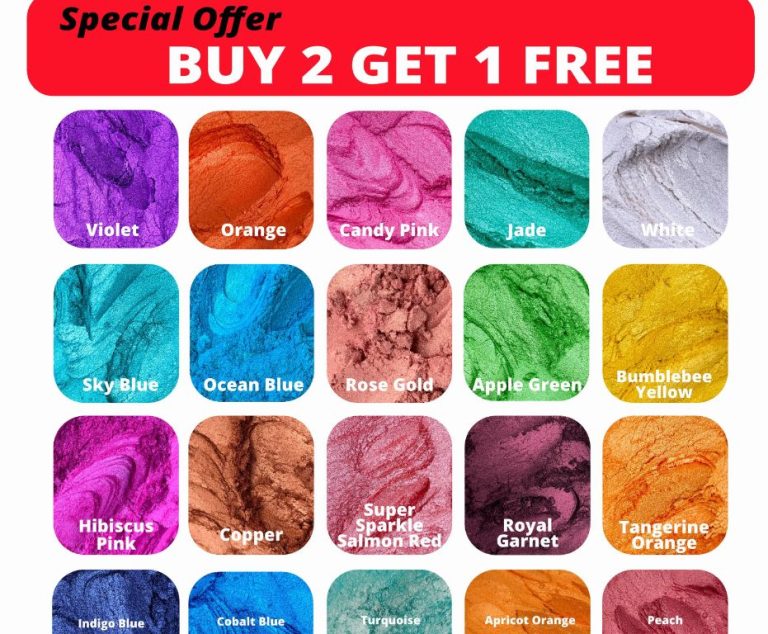What Is Cosmetic Mica Powder?
What is Mica Powder?
Mica powder is a naturally occurring mineral dust that is derived from rocks containing mica, silicate minerals consisting of varying amounts of aluminum, potassium, magnesium, iron and water. It occurs in layered sheets that can be peeled into very thin flakes or ground into fine powders. Mica is known for its shimmery, pearlescent sheen and lightweight consistency due to its thin, translucent flakes 1.
The key properties that make mica useful as an ingredient in cosmetics are its natural shimmer, sheer coverage, lightweight texture and smooth feel. The thin plates reflect and refract light to create a subtle glow. When mica is ground into a fine powder, it maintains its translucent, shimmery effect while allowing products to go on smoothly. The powder is very lightweight and adds only a delicate iridescence without appearing or feeling heavy. This makes mica well-suited for enhancing the natural glow in blushes, eyeshadows, highlighters and other cosmetics 1.
Types of Mica Powder
There are three main types of mica powder used in cosmetics:
Sericite Mica
Sericite mica is the most common type used in cosmetics. It has a fine texture and provides a silky feel and shimmer. Sericite mica is muscovite mica that has been ground into a fine powder. It reflects light evenly for a smooth, metallic finish on the skin (1).
Synthetic Mica
Synthetic mica is man-made from a variety of silicates. The manufacturing process allows the particle size and shimmer to be customized. Synthetic mica tends to have good coverage capabilities and creates a sparkly effect. However, the shimmer particles can sometimes be larger and appear more glittery than natural mica (1).
Natural Mica
Natural mica is mined and then purified and color enhanced. It provides a pearl-like shimmer from the flake structure. Natural mica can create sheer to intense shimmer effects depending on the particle size. It has a crystalline appearance that diffuses light softly for a multidimensional shimmer on the skin (2).
(1) https://eyecandypigments.com/blogs/news/the-different-types-of-mica-and-which-is-body-safe
(2) https://justpigments.com/collections/mica-powder
Uses of Mica Powder
Mica powder is widely used in cosmetics and makeup products thanks to its shimmery, pearlescent properties. When mica powder is added to products like eyeshadow, lipgloss, highlighter, and blush, it provides a luminous, radiant finish.
One of the main cosmetic uses for mica powder is in mineral makeup foundations. The powder binds to the skin, smoothing imperfections while adding a subtle glow. Mica reflects light away from fine lines and pores, helping create a more youthful complexion.
Another major cosmetic use is in colored powders like blush, bronzer, and luminizers. Mica powder’s shimmer flatters all skin tones and helps enhance cheekbones. When added to lip colors, mica gives lips a fuller, plumper appearance.
In eye makeup, mica powder is commonly found in shimmery eyeshadows, providing metallic sheen and multi-dimensional shading. It allows for a creamy, bendable texture that applies evenly. Mica also adds pigment and shine to products like eyebrow pencils, eyeliners, and mascaras.
Overall, the reflective quality of mica powder gives makeup a brightening effect, while the lightweight texture prevents caking. It provides smooth application and longevity when added to cosmetics.
How Mica Powder is Produced
Mica powder originates from mica deposits mined in various parts of the world. The majority of the world’s mica is extracted in India and China. Mica mining is a delicate process because mica is often found in conjunction with minerals like feldspar and quartz. The process starts by identifying and extracting mica-rich rocks from the earth. These rocks are then cleaned, sorted, and processed into a fine powder.
To turn raw mica pieces into a usable powder, the mica goes through a multi-step crushing, grinding, and sieving process. First, the raw mica is crushed into smaller fragments using jaw crushers or roll crushers. It is then ground into a fine powder using ball mills or other pulverizing systems. This powder is further processed through a series of sieves to filter out large particles and achieve the desired fineness. The mica powder particles are extremely small, often ranging from 5-150 microns in size. This allows them to reflect light evenly and create a pearlescent effect.

High-quality cosmetic mica powders are triple or quadruple milled to ensure a super fine and consistent texture. The milling and sieving process removes impurities and allows mica powders to be classified into different grades or mesh sizes. The soft, sheer nature of the powder makes mica suitable for use in various cosmetics and skin care applications.
Benefits of Mica Powder
One of the key benefits of mica powder is that it gives cosmetics and skincare products a shimmery, glowy effect. Mica’s ability to refract and reflect light results in a luminous finish when added to formulas (1). The natural shimmer of mica powders creates highlights on the skin that catch and reflect light, giving the complexion a radiant glow (2).
Mica also has a very smooth and blendable texture when ground into a fine powder. This allows it to be easily incorporated into cosmetics and provides a velvety feel when applied. The fineness of mica powder particles enables them to lay flat on the skin, creating an ultra-smooth finish without emphasizing fine lines or pores (3). Overall, mica powder’s light-reflecting abilities and smooth texture make it an ideal ingredient for creating flawless, luminous makeup with a soft focus effect.
Considerations When Using Mica Powder
When using mica powder in cosmetics, there are a few considerations to keep in mind:
Mica powder can emphasize dry patches and texture on the skin. The shimmery particles in mica powder will cling to and accentuate any flakiness or dry areas on the face. Using a moisturizing primer underneath mica powder can help minimize this effect.
Mica powders tend to be very soft and finely milled, which also makes them messy to work with. There is often a lot of fallout when dipping brushes into pure mica powder. Some options to reduce messiness include: using a patting or pressing motion instead of sweeping, doing application over a sink, tapping off excess powder before applying. Using mica as just a highlight rather than all over the face also minimizes waste and mess.
Some concerns have also been raised over the mining practices for natural mica powders. Synthetic mica alternatives avoid the ethical issues associated with natural mica mining. Sources like Treehugger provide more details on sustainability and sourcing concerns.
Application Tips
When using mica powder for cosmetics, it’s important to apply it properly for the best results. Here are some tips:
Use with a light hand. Only use a small amount of mica powder at a time. Tap off any excess from the brush before applying. It’s easy to overdo it with mica powder, so build up the intensity slowly. Start with a sheer wash of color and intensify as desired.
Tap off excess. Before sweeping the mica powder where you want it, be sure to tap the brush to remove any loose excess powder. This will give you better control over the application.
Use over primer. Apply mica powder over an eyeshadow primer, foundation, or moisturizer. This helps the mica adhere better to the skin and last longer. The primer also intensifies the effect of the mica powder.
DIY Cosmetics with Mica Powder
Mica powder allows you to create your own shimmering DIY cosmetics at home with just a few simple ingredients. One of the most popular uses of mica powder is for homemade eyeshadows. You can create beautiful shimmery eyeshadows easily using mica powder pigments. According to Treehugger, a simple eyeshadow recipe only requires mixing 1/4 teaspoon of cosmetic grade mica powder with a few drops of rubbing alcohol and oil like vitamin E or jojoba oil.[1] The mica powder provides the pigment and shimmer, while the rubbing alcohol and oil turn it into a creamy eyeshadow texture. You can customize the shade by using different colored mica powders.
Mica powder can also be used to add shine and shimmer to homemade lip glosses and lipsticks. A basic lip gloss recipe calls for mixing together mica powder, beeswax, and oils like almond and jojoba. Once combined and melted, the mixture can be poured into lip gloss tubes or tins. The mica powder gives it a lustrous, light-catching effect. You can also add extra pigments like beetroot powder or turmeric for tinted glosses.[2] For a creamy lipstick, add more beeswax or experiment with different carrier oils. The possibilities are endless when making your own glittery cosmetics with mica!
Mica Powder Brands
When shopping for mica powder, there are many reputable brands to choose from. Some popular pre-made cosmetic products containing mica include:
Eyeshadow palettes from brands like Urban Decay, NARS, and Glossier often contain mica for its shimmery, multifaceted effect.
Lip glosses and lipsticks like Maybelline Lifter Glosses and NYX Butter Lipsticks rely on mica for a smooth, reflective finish.
For loose mica powders, some of the most popular cosmetic-grade options include:
- Arteza – Wide selection of colors, high quality.
- TKbTrading – Many sizes and pigment options.
- Pure Anada – All natural, clean mica.
With so many shades and finishes available, mica powder allows cosmetic creators to achieve nearly any desired effect.
The Future of Mica Powder
The future of mica powder will depend heavily on developing ethical and sustainable sourcing methods. Much of the world’s mica comes from illegal mining operations with poor labor conditions, especially in India where child labor is a major concern (see this article). The cosmetics industry is pushing for regulations to ensure mica is obtained through legal channels with fair working conditions. New mining cooperatives are also being formed to give local communities more control over the process.
Innovations in mica alternatives will also shape the future landscape. Companies are experimenting with synthetics like synthetic fluorphlogopite as well as other natural mineral powders with similar effects. Formulas that use less mica or fully replace it are on the rise. However, the unique properties of natural mica will likely keep it relevant even as alternative options grow. Developments in sustainable and ethical sourcing will allow natural mica to remain an important ingredient in cosmetics with less environmental and social impact.






